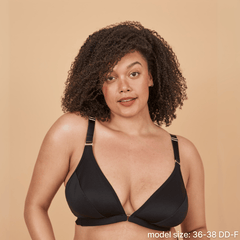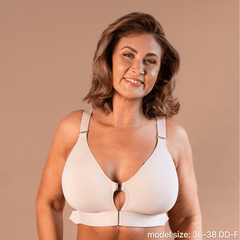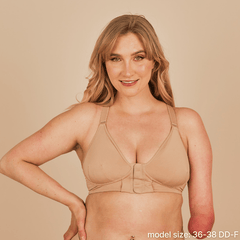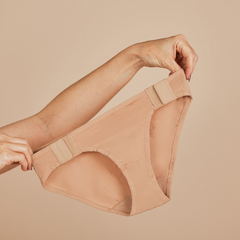Chronic pain clothing can be life-changing for those living with daily discomfort. Chronic pain, whether from arthritis, fibromyalgia, or another long-term condition, can make everyday tasks uncomfortable.
Adaptive clothing designed with specialist features, can be the ideal alternative and help alleviate some of this daily discomfort.
Let’s explore which features you should be looking for in chronic illness clothing, and understand why adding a few pieces to your current wardrobe can be so useful.

Understanding Chronic Pain and Its Impact on Clothing Choices
Chronic pain can be caused by various conditions. Whilst symptoms and severity will vary for each individual, it often involves persistent pain in the muscles, joints, or nerves, leading to heightened sensitivity and discomfort.
Traditional clothing, with its restrictive fabrics, tight seams, and awkward closures, can exacerbate pain or limit mobility. This is where adaptive clothing comes in.
People with chronic pain need clothing that accommodates their specific needs, offering flexibility, ease of wear, and minimal pressure on sensitive areas.
Key Features of Chronic Pain Clothing
Adaptive clothing, and specifically chronic pain clothing, is designed with mobility in mind. It will have special features to try and alleviate some discomfort.
The features that are most useful will vary for each person, but which should you look out for?
Soft, Breathable Fabrics
The type of fabric can impact chronic pain. Try to look for materials like cotton, bamboo, and modal, which are gentle on the skin and allow for proper airflow.
Similarly, stretchy fabrics can be a good option if swelling is a concern. It can allow for more flexibility in fit.
Minimal Seams and Tagless Designs
Seams and tags can irritate sensitive skin or press uncomfortably against painful areas. Clothing designed for chronic pain often features flat or minimal seams and tagless designs to eliminate these pressure points.
Easy Closures and Adaptive Designs
For those with chronic pain, closures can be difficult. Traditional buttons or zippers aren’t always simple, particularly for those with arthritis or limited mobility in their hands, wrists or shoulders.
Adaptive clothing often has easy-to-use closures like Velcro, magnets, or pull-on designs, which reduce strain on the hands and wrists. If you’re choosing adaptive fasteners be aware that things like magnets can interfere with pacemakers and other medical devices.
Loose, Non-Restrictive Fits
Clothing that is too tight can exacerbate pain, especially in areas prone to swelling or stiffness. Chronic pain clothing will often allow for free movement and won’t constrict the body. This is particularly important for those with joint pain, as it reduces the pressure on sensitive areas.
Layering for Temperature Control
Temperature regulation is a common concern for individuals with chronic pain.
Layering clothing allows for easy adjustment to changing temperatures, which can help manage pain levels.
Lightweight, breathable layers can be added or removed as needed to maintain comfort.

Tips for Choosing Chronic Pain Clothing
So what should you prioritize when shopping for chronic pain clothing?
1. Prioritize Comfort
When shopping for clothing, always try to prioritize comfort. While it’s important to feel good about how you look, comfort should be the primary consideration, especially if you’re dealing with chronic pain.
Luckily, adaptive clothing is much better now in terms of appearance and there are plenty of companies making adaptive clothing that both feels and looks great.
2. Try Before You Buy
Whenever possible, try on clothing before purchasing to ensure a good fit and feel. Pay attention to how the fabric feels against your skin, how easy the clothing is to put on and take off, and whether it offers the flexibility and support you need.
Try to judge clothing on how it would fare during times of extreme discomfort or flare-ups to make sure you can really benefit.
3. Consider Layering Options
Layering allows you to adapt to changes in temperature throughout the day. Choose lightweight, breathable clothing that can be easily layered to provide warmth or coolness as needed.
4. Look for Adaptive Clothing Brands
Many brands now specialize in adaptive clothing designed specifically for individuals with chronic pain or other disabilities. These brands offer stylish, adaptive options and are regularly updating their ranges. You could follow some brands on social media or subscribe to newsletters to make sure you’re aware of which products are available.
Essential Clothing Items for Chronic Pain Sufferers
What are the essentials when it comes to chronic pain clothing?
Elastic Waist Pants and Leggings
When it comes to pants, there are a couple of options for those with chronic pain.
During periods of discomfort, pull-on pants with wide legs and non-restrictive materials can be a great option. They account for potential swelling and eliminate the need for zippers, buttons and restrictive waistbands.
On the other hand, leggings, particularly those made from soft, stretchy fabrics can be a good option if you instead need gentle support without the material being too tight.
The option that is best for you may depend on where you most often experience pain and the level of support you need.
Adaptive Bras
Bras designed for chronic pain are key for support without discomfort.
Adaptive bras, like the Springrose front closure bra that have Velcro fastens at the front under the cup can reduce lots of strain on the shoulders and back when dressing. The Velcro also provides some flexibility to account for any swelling.
Comfortable Footwear
When considering chronic pain clothing you should include footwear, which can be key for everyday comfort and mobility.
Any shoes you choose should have good arch support and cushioning, and fit comfortably to prevent additional strain on the feet, knees, and hips.
Slip-on designs are ideal for ease of use, but magnetic laces can also be a good option if shoes need to be more secure.
Adaptive Outerwear
We’ve spoken about the importance of layering for chronic pain and this should include any outerwear.
Jackets and coats need to be easy to put on and take off when on the go. If zippers are uncomfortable you could try magnets or simple belted designs to simplify dressing. A simple tied belt can secure a coat or jacket without the need for additional poppers or buttons, removing uncomfortable movements from the process..
Conclusion
By prioritizing comfort, ease of use, and adaptability, you can build a wardrobe that supports your needs and helps you navigate each day with greater ease. Whether you’re dealing with fibromyalgia, arthritis, or any other condition that causes chronic pain, the right clothing can make a significant difference in how you feel and how you move through the world.



